An Efficient Peptide Screening Method for Mineral-Binding Peptides
Abstract
:1. Introduction
2. Materials and Experimental Methods
2.1. Materials
2.1.1. Peptides
2.1.2. Water and Reagents
2.1.3. Minerals
2.2. Techniques
2.2.1. Fluorescence Microscopy
2.2.2. pH and Eh Measurements
2.2.3. Optical Tensiometer
2.2.4. Image Processing Software
3. Method Development
3.1. Identification of the Target Binding Species on the Mineral Surface
- Arsenite, under reducing conditions, which includes H3AsO3, H2AsO3−, HAsO32− and AsO43− ions;
- Arsenate, under oxidizing conditions, which includes H3AsO4, H2AsO4-, HAsO4-, HAsO42−, HAsO42− and AsO43− ions.
3.2. Identification of Peptide Sequences That Bind to the Target Species
- The enargite binding peptides: PEng-1, PEng-2, PEng-3;
- The arsenic-ion binding peptides: PAs-3, PAs-35;
- The arsenic-oxyanion binding peptides: PAsO-1, PAsO-2.
3.3. Synthesis of the Peptide Sequences with a Fluorescent Tag
3.4. Testing of the Peptide Adsorption on Flat Mineral Surfaces
- Two peptide solvents: Milli-Q water and Britton-Robinson buffer solution (BRB);
- Three pH conditions: pH 5, 7 and 9;
- Four minerals: arsenopyrite, pyrite, enargite and chalcopyrite;
- Presence of methyl isobutyl carbinol (MIBC) in solution, the most common flotation frother (10 μL MIBC/L peptide solution).
- Step 1: Adsorption of peptide
- Step 2: Drying of surfaces
- Step 3: Observation under the microscope
- Step 4: Surface Resetting
- (a)
- Soaking the mineral surface containing the adsorbed peptide in the following solutions: Milli-Q water, 90% ethanol, 100% ethanol, acetone, 0.5 M/1 M/2 M sodium hydroxide, 0.1 M/1 M hydrochloric acid, 0.5 wt.% Tween 80 and glycine elution buffer (0.2 M Glycine-HCl at pH 2.2 with 1 mg/mL bovine serum albumin);
- (b)
- Polishing the mineral surfaces using a 3-micron cloth polishing disc, 80-grit and 180-grit sand polishing discs. After the polishing, the mineral surfaces were rinsed with Milli-Q water, dried with nitrogen gas and observed under the fluorescence microscope to detect the presence of any residue of the peptide.
- Step 5: Selection of peptide candidates as potential flotation collectors
4. Results
4.1. Testing Conditions
4.2. Semi-Quantification of Peptide Adsorption
- No fluorescence observed: ×
- A small amount of fluorescence is observed: √
- A moderate amount of fluorescence is observed: √√
- A high amount of fluorescence is observed: √√√
4.3. The 1st Adsorption Test Screening—Peptide Dissolved in Milli-Q Water
4.4. The 2nd Adsorption Test Screening—Peptide Dissolved in pH-Adjusted BRB
4.5. The 3rd Adsorption Test Screening—Peptide Dissolved in pH-Adjusted BRB with Frother MIBC
4.6. Quantification of Peptide Coverage
4.7. Contact Angle Measurement
4.8. Discussion
- Identify peptide sequences that bind selectively to the target minerals and the pH conditions to achieve optimal binding, i.e., peptide adsorption on the mineral surfaces.
- Test the peptide binding performance under flotation conditions (i.e., the presence of frother).
- Assess the hydrophobicity properties of the peptide.
- Establish proof-of-concept for the method developed to select peptide candidates as potential flotation reagents to selectively recover the minerals of interest.
4.9. Future Work
5. Conclusions and Recommendations
Author Contributions
Funding
Data Availability Statement
Acknowledgments
Conflicts of Interest
References
- Watari, T.; Nansai, K.; Nakajima, K. Major metals demand, supply, and environmental impacts to 2100: A critical review. Resour. Conserv. Recycl. 2021, 164, 105107. [Google Scholar] [CrossRef]
- Nazari, A.M.; Radzinski, R.; Ghahreman, A. Review of arsenic metallurgy: Treatment of arsenical minerals and the immobilization of arsenic. Hydrometallurgy 2017, 174, 258–281. [Google Scholar] [CrossRef]
- Flores, G.A.; Risopatron, C.; Pease, J. Processing of Complex Materials in the Copper Industry: Challenges and Opportunities Ahead. JOM 2020, 72, 3447–3461. [Google Scholar] [CrossRef]
- Agency for Toxic Substances and Disease Registry. ATSDR’s Substance Priority List. Available online: https://www.atsdr.cdc.gov/spl/index.html (accessed on 1 August 2022).
- Morizot, G.; Ollivier, P. A process for the economic beneficiation of As- and As Au-bearing antimony ores. Has the dream become a reality? Miner. Eng. 1993, 6, 841–856. [Google Scholar] [CrossRef]
- Chowdhry, M.C. Theoretical Study on Reactivity of Different Sulfide Collectors and Their Binding Affinity toward Cu(II), Zn(II) and Pb(II) Ions. Ph.D. Dissertation, University of Alberta, Edmonton, AB, Canada, 2015. [Google Scholar]
- Wills, B.A.; Finch, J.A. Chapter 12—Froth Flotation. In Wills’ Mineral Processing Technology, 8th ed.; Wills, B.A., Finch, J.A., Eds.; Butterworth-Heinemann: Boston, MA, USA, 2016; pp. 265–380. [Google Scholar] [CrossRef]
- Ma, X.; Bruckard, W.J. Rejection of arsenic minerals in sulfide flotation—A literature review. Int. J. Miner. Process. 2009, 93, 89–94. [Google Scholar] [CrossRef]
- Smedley, P.L.; Kinniburgh, D.G. A review of the source, behaviour and distribution of arsenic in natural waters. Appl. Geochem. 2002, 17, 517–568. [Google Scholar] [CrossRef]
- Drahota, P.; Filippi, M. Secondary arsenic minerals in the environment: A review. Environ. Int. 2009, 35, 1243–1255. [Google Scholar] [CrossRef]
- Silva, J.C.M.; dos Santos, E.C.; Heine, T.; De Abreu, H.A.; Duarte, H.A. Oxidation Mechanism of Arsenopyrite in the Presence of Water. J. Phys. Chem. C 2017, 121, 26887–26894. [Google Scholar] [CrossRef]
- Dunbar, W.S. Biotechnology and the Mine of Tomorrow. Trends Biotechnol. 2017, 35, 79–89. [Google Scholar] [CrossRef]
- Curtis, S.B.; MacGillivray, R.T.A.; Dunbar, W.S. Effects of bacteriophage on the surface properties of chalcopyrite (CuFeS2), and phage-induced flocculation of chalcopyrite, glacial till, and oil sands tailings. Biotechnol. Bioeng. 2011, 108, 1579–1590. [Google Scholar] [CrossRef]
- Lemloh, M.-L.; Altintoprak, K.; Wege, C.; Weiss, I.M.; Rothenstein, D. Biogenic and Synthetic Peptides with Oppositely Charged Amino Acids as Binding Sites for Mineralization. Materials 2017, 10, 119. [Google Scholar] [CrossRef] [PubMed]
- Liao, C.-W. Inorganic Binding Peptides Designed by Phage Display Techniques for Biotechnology Applications. Ph.D. Thesis, University of Florida, Ann Arbor, MI, USA, 2010. [Google Scholar]
- Fermin, G.; Rampersad, S.; Tennant, P. Chapter 12—Viruses as Tools of Biotechnology: Therapeutic Agents, Carriers of Therapeutic Agents and Genes, Nanomaterials, and More. In Viruses; Tennant, P., Fermin, G., Foster, J.E., Eds.; Academic Press: Cambridge, MA, USA, 2018; pp. 291–316. [Google Scholar] [CrossRef]
- Cetinel, S.; Shen, W.-Z.; Aminpour, M.; Bhomkar, P.; Wang, F.; Borujeny, E.R.; Sharma, K.; Nayebi, N.; Montemagno, C. Biomining of MoS2 with Peptide-based Smart Biomaterials. Sci. Rep. 2018, 8, 3374. [Google Scholar] [CrossRef] [PubMed]
- Hnilova, M.; Oren, E.E.; Seker, U.O.S.; Wilson, B.R.; Collino, S.; Evans, J.S.; Tamerler, C.; Sarikaya, M. Effect of Molecular Conformations on the Adsorption Behavior of Gold-Binding Peptides. Langmuir 2008, 24, 12440–12445. [Google Scholar] [CrossRef] [PubMed]
- Nam, K.T.; Kim, D.-W.; Yoo, P.J.; Chiang, C.-Y.; Meethong, N.; Hammond, P.T.; Chiang, Y.-M.; Belcher, A.M. Virus-Enabled Synthesis and Assembly of Nanowires for Lithium Ion Battery Electrodes. Science 2006, 312, 885–888. [Google Scholar] [CrossRef]
- Huang, Y.; Chiang, C.-Y.; Lee, S.K.; Gao, Y.; Hu, E.L.; Yoreo, J.D.; Belcher, A.M. Programmable Assembly of Nanoarchitectures Using Genetically Engineered Viruses. Nano Lett. 2005, 5, 1429–1434. [Google Scholar] [CrossRef]
- Pacardo, D.B.; Sethi, M.; Jones, S.E.; Naik, R.R.; Knecht, M.R. Biomimetic Synthesis of Pd Nanocatalysts for the Stille Coupling Reaction. ACS Nano 2009, 3, 1288–1296. [Google Scholar] [CrossRef]
- Li, Y.; Huang, Y. Morphology-Controlled Synthesis of Platinum Nanocrystals with Specific Peptides. Adv. Mater. 2010, 22, 1921–1925. [Google Scholar] [CrossRef]
- Naik, R.R.; Stringer, S.J.; Agarwal, G.; Jones, S.E.; Stone, M.O. Biomimetic synthesis and patterning of silver nanoparticles. Nat. Mater. 2002, 1, 169–172. [Google Scholar] [CrossRef]
- Sano, K.I.; Shiba, K. A Hexapeptide Motif that Electrostatically Binds to the Surface of Titanium. J. Am. Chem. Soc. 2003, 125, 14234–14235. [Google Scholar] [CrossRef] [PubMed]
- Khatayevich, D.; Gungormus, M.; Yazici, H.; So, C.; Cetinel, S.; Ma, H.; Jen, A.; Tamerler, C.; Sarikaya, M. Biofunctionalization of materials for implants using engineered peptides. Acta Biomater. 2010, 6, 4634–4641. [Google Scholar] [CrossRef] [PubMed]
- Brown, S.; Brown, S. Engineering iron oxide-adhesion mutants of Escherichia coli phage receptor. Proc. Natl. Acad. Sci. USA 1992, 89, 8651–8655. [Google Scholar] [CrossRef]
- Umetsu, M.; Mizuta, M.; Tsumoto, K.; Ohara, S.; Takami, S.; Watanabe, H.; Kumagai, I.; Adschiri, T. Bioassisted Room-Temperature Immobilization and Mineralization of Zinc Oxide—The Structural Ordering of ZnO Nanoparticles into a Flower-Type Morphology. Adv. Mater. 2005, 17, 2571–2575. [Google Scholar] [CrossRef]
- Thai, C.K.; Dai, H.; Sastry, M.S.R.; Sarikaya, M.; Schwartz, D.T.; Baneyx, F. Identification and characterization of Cu2O- and ZnO-binding polypeptides by Escherichia coli cell surface display: Toward an understanding of metal oxide binding. Biotechnol. Bioeng. 2004, 87, 129–137. [Google Scholar] [CrossRef] [PubMed]
- Mao, C.; Flynn, C.E.; Hayhurst, A.; Sweeney, R.; Qi, J.; Georgiou, G.; Iverson, B.; Belcher, A.M. Viral assembly of oriented quantum dot nanowires. Proc. Natl. Acad. Sci. USA 2003, 100, 6946–6951. [Google Scholar] [CrossRef]
- Zhou, W.; Schwartz, D.T.; Baneyx, F. Single-Pot Biofabrication of Zinc Sulfide Immuno-Quantum Dots. J. Am. Chem. Soc. 2010, 132, 4731–4738. [Google Scholar] [CrossRef] [PubMed]
- Chiu, D.; Zhou, W.; Kitayaporn, S.; Schwartz, D.T.; Murali-Krishna, K.; Kavanagh, T.J.; Baneyx, F. Biomineralization and Size Control of Stable Calcium Phosphate Core–Protein Shell Nanoparticles: Potential for Vaccine Applications. Bioconjugate Chem. 2012, 23, 610–617. [Google Scholar] [CrossRef] [PubMed]
- Tran, N.H.T.; Trinh, K.T.L.; Lee, J.-H.; Yoon, W.J.; Ju, H. Fluorescence Enhancement Using Bimetal Surface Plasmon-Coupled Emission from 5-Carboxyfluorescein (FAM). Micromachines 2018, 9, 460. [Google Scholar] [CrossRef]
- Bissen, M.; Frimmel, F.H. Arsenic—A Review. Part I: Occurrence, Toxicity, Speciation, Mobility. Acta Hydrochim. Et Hydrobiol. 2003, 31, 9–18. [Google Scholar] [CrossRef]
- Flora, S.J.S. 1—Arsenic: Chemistry, Occurrence, and Exposure. In Handbook of Arsenic Toxicology; Flora, S.J.S., Ed.; Academic Press: Oxford, UK, 2015; pp. 1–49. [Google Scholar] [CrossRef]
- James, K.A.; Meliker, J.R.; Nriagu, J.O. Arsenic. In International Encyclopedia of Public Health, 2nd ed.; Quah, S.R., Ed.; Academic Press: Oxford, UK, 2017; pp. 170–175. [Google Scholar] [CrossRef]
- Yang, T.; Zhang, X.-X.; Yang, J.-Y.; Wang, Y.-T.; Chen, M.-L. Screening arsenic(III)-binding peptide for colorimetric detection of arsenic(III) based on the peptide induced aggregation of gold nanoparticles. Talanta 2018, 177, 212–216. [Google Scholar] [CrossRef]
- Braun, R.; Schönberger, N.; Vinke, S.; Lederer, F.; Kalinowski, J.; Pollmann, K. Application of Next Generation Sequencing (NGS) in Phage Displayed Peptide Selection to Support the Identification of Arsenic-Binding Motifs. Viruses 2020, 12, 1360. [Google Scholar] [CrossRef] [PubMed]
- Kyuhyeong, P.; Choi, J.; Gomez, A.; Kim, H. Flotation Behavior of Arsenopyrite and Pyrite, and Their Selective Separation. Mater. Trans. 2015, 56, 435–440. [Google Scholar] [CrossRef]
- Beattie, M.J.; Duteroue, J.P. Flotation Separation of Arsenopyrite from Pyrite. U.S. Patent US5171428A, 15 December 1992. [Google Scholar]
- Asta, M.P.; Cama, J.; Ayora, C.; Acero, P.; de Giudici, G. Arsenopyrite dissolution rates in O2-bearing solutions. Chem. Geol. 2010, 273, 272–285. [Google Scholar] [CrossRef]
- Corkhill, C.L.; Wincott, P.L.; Lloyd, J.R.; Vaughan, D.J. The Oxidative Dissolution of Arsenopyrite (FeAsS) and Enargite (Cu3AsS4) by Leptospirillum Ferrooxidans. Geochim. Cosmochim. Acta 2008, 72, 5616. [Google Scholar] [CrossRef]
- Wang, X.H.; Ahlberg, E.; Forssberg, K.S.E. Electrochemical study of surface oxidation and collectorless flotation of arsenopyrite. J. Appl. Electrochem. 1992, 22, 1095–1103. [Google Scholar] [CrossRef]
- Cruz-Huerta, E.; Maqueda, D.M.; de la Hoz, L.; Nunes da Silva, V.S.; Pacheco, M.T.B.; Amigo, L.; Recio, I. Short communication: Identification of iron-binding peptides from whey protein hydrolysates using iron (III)-immobilized metal ion affinity chromatographyand reversed phase-HPLC-tandem mass spectrometry. J. Dairy Sci. 2016, 99, 77–82. [Google Scholar] [CrossRef] [PubMed]
- Fernandez, P.; Linge, H.; Wadsley, M. Oxidation of arsenopyrite (FeAsS) in acid Part I: Reactivity of arsenopyrite. J. Appl. Electrochem. 1996, 26, 575–583. [Google Scholar] [CrossRef]
- Yu, L.; Liu, Q.; Li, S.; Deng, J.; Luo, B.; Lai, H. Depression mechanism involving Fe3+ during arsenopyrite flotation. Sep. Purif. Technol. 2019, 222, 109–116. [Google Scholar] [CrossRef]
- Craw, D.; Falconer, D.; Youngson, J. Environmental arsenopyrite stability and dissolution: Theory, experiment, and field observations. Chem. Geol. 2003, 199, 71–82. [Google Scholar] [CrossRef]
- Moslemi, H.; Gharabaghi, M. A review on electrochemical behavior of pyrite in the froth flotation process. J. Ind. Eng. Chem. 2016, 47, 1–18. [Google Scholar] [CrossRef]
- Yin, L.; Yang, H.-Y.; Tong, L.-L.; Ma, P.-C.; Zhang, Q.; Zhao, M.-M. Arsenopyrite Bio-Oxidization Behavior in Bioleaching Process: Evidence from Laser Microscopy, SEM-EDS, and XPS. Front. Microbiol. 2020, 11, 1773. [Google Scholar] [CrossRef]
- Jung, M.Y.; Heo, W.; kyu Son, S. Relationship between Surface Roughness and Contact Angle of Pyrite. J. Korean Soc. Miner. Energy Resour. Eng. 2014, 51, 349–357. [Google Scholar] [CrossRef]
- An, D.; Zhang, J. A Study of Temperature Effect on the Xanthate’s Performance during Chalcopyrite Flotation. Minerals 2020, 10, 426. [Google Scholar] [CrossRef]
- Chen, J.; Xu, Z.; Chen, Y. Chapter 7—Electronic structures and surface adsorption of impurity-bearing sulfide minerals. In Electronic Structure and Surfaces of Sulfide Minerals; Chen, J., Xu, Z., Chen, Y., Eds.; Elsevier: Amsterdam, The Netherlands, 2020; pp. 307–359. [Google Scholar] [CrossRef]
- Himawan, T.B.M.; Hirajima, T.; Sasaki, K.; Okamoto, H. Alternative techniques to separate tennantite from chalcopyrite: Single minerals and arseno copper ore flotation study. In Proceedings of the 26th International Mineral Processing Congress, IMPC 2012: Innovative Processing for Sustainable Growth—Conference Proceedings, New Delhi, India, 24–28 September 2012; pp. 2038–2051. [Google Scholar]
- Sharma, P.K.; Hanumantha Rao, K. Adhesion of Paenibacillus polymyxa on chalcopyrite and pyrite: Surface thermodynamics and extended DLVO theory. Colloids Surf. B Biointerfaces 2003, 29, 21–38. [Google Scholar] [CrossRef]
- Gan, Y.; Deng, R.; Liu, Q. Flotation Separation of Covellite and Enargite via Oxidation Treatment. Minerals 2022, 12, 970. [Google Scholar] [CrossRef]

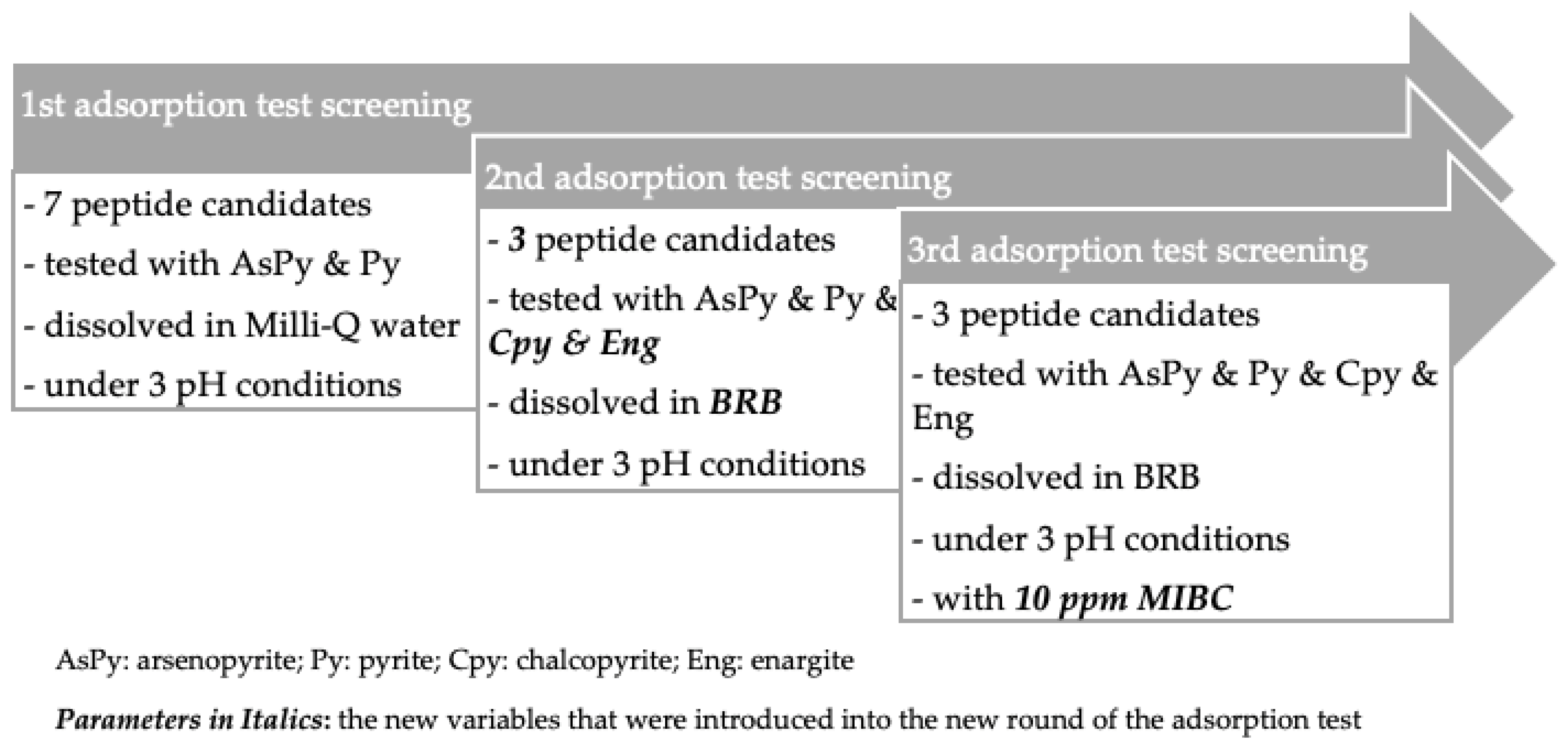

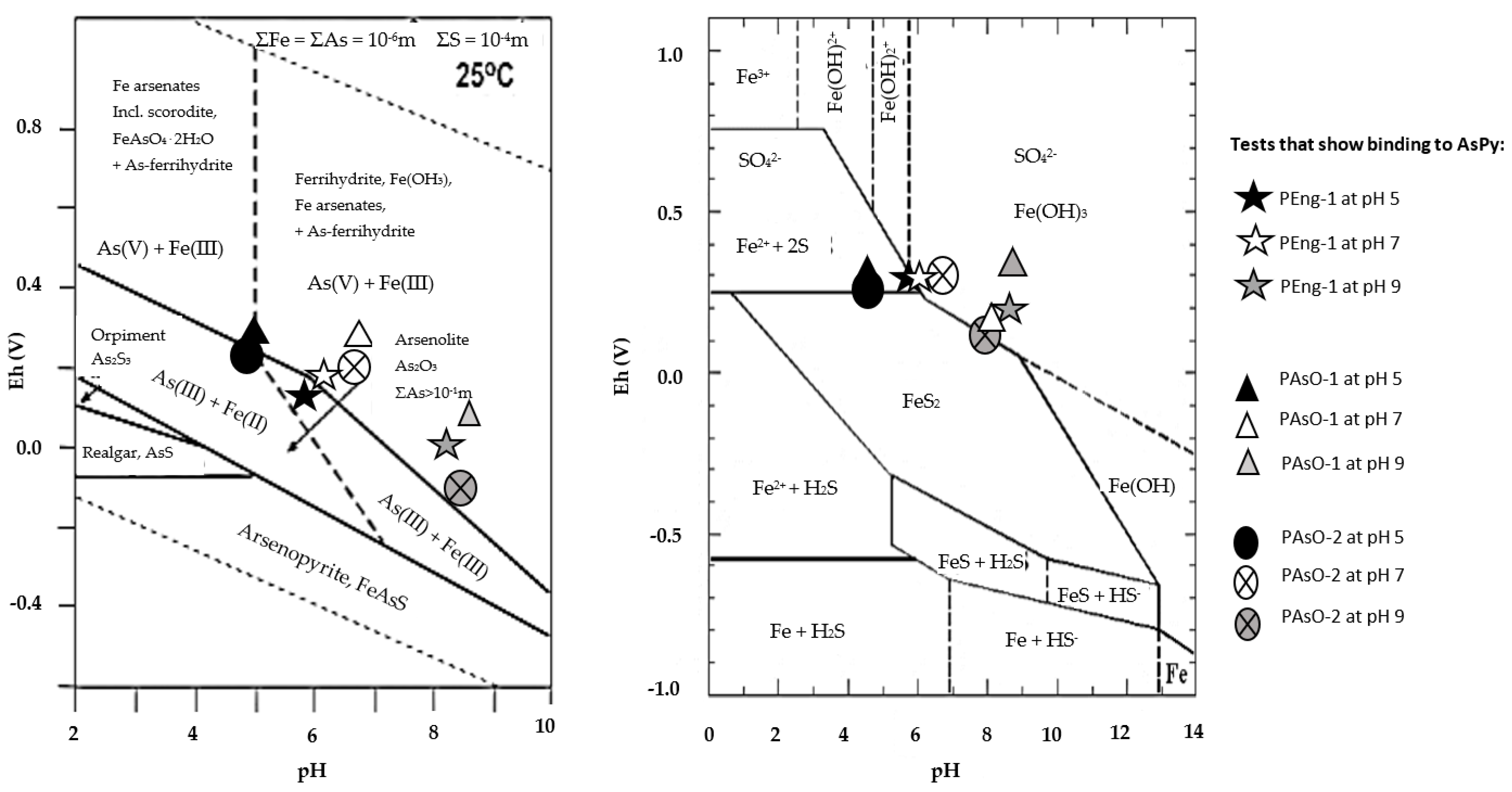
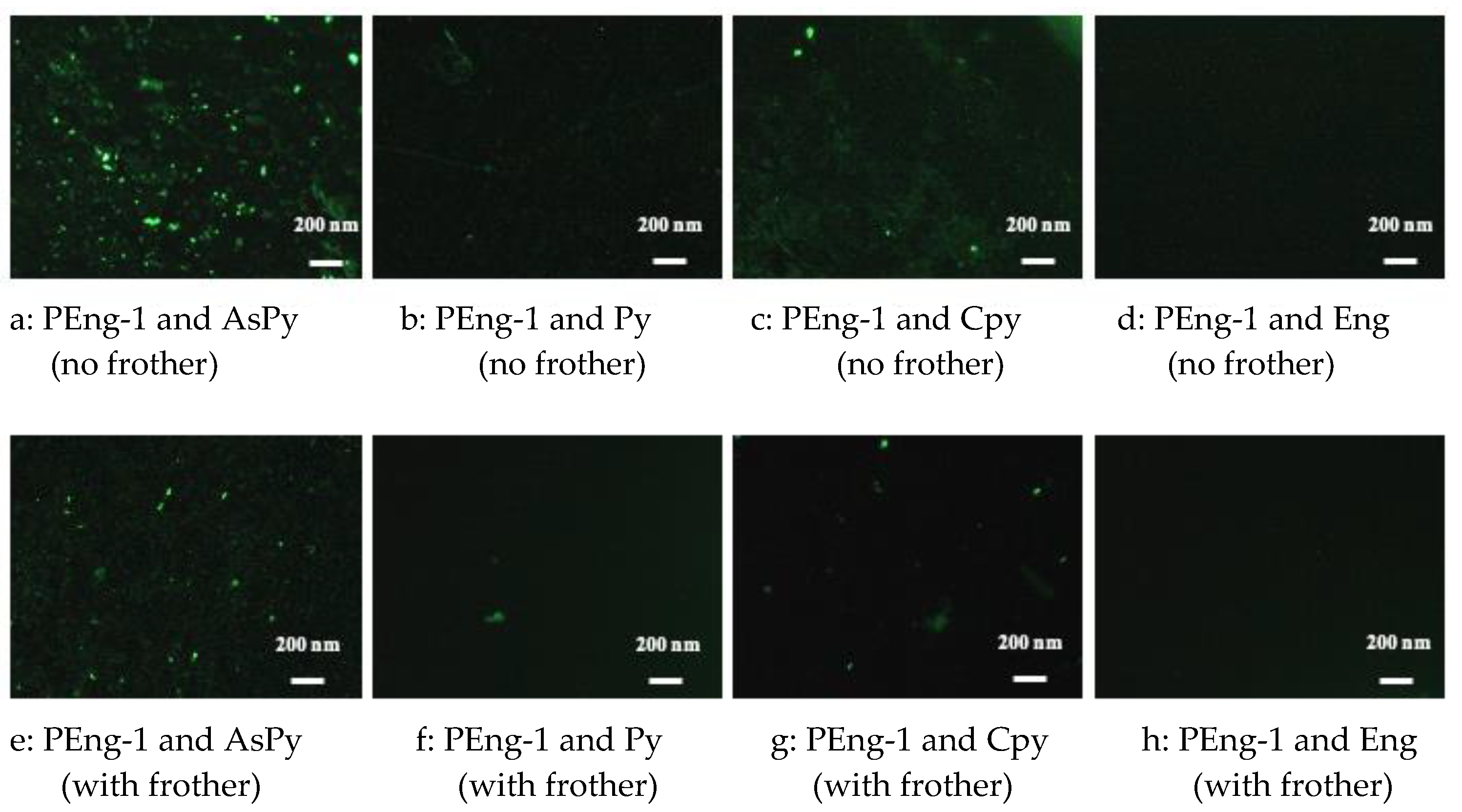
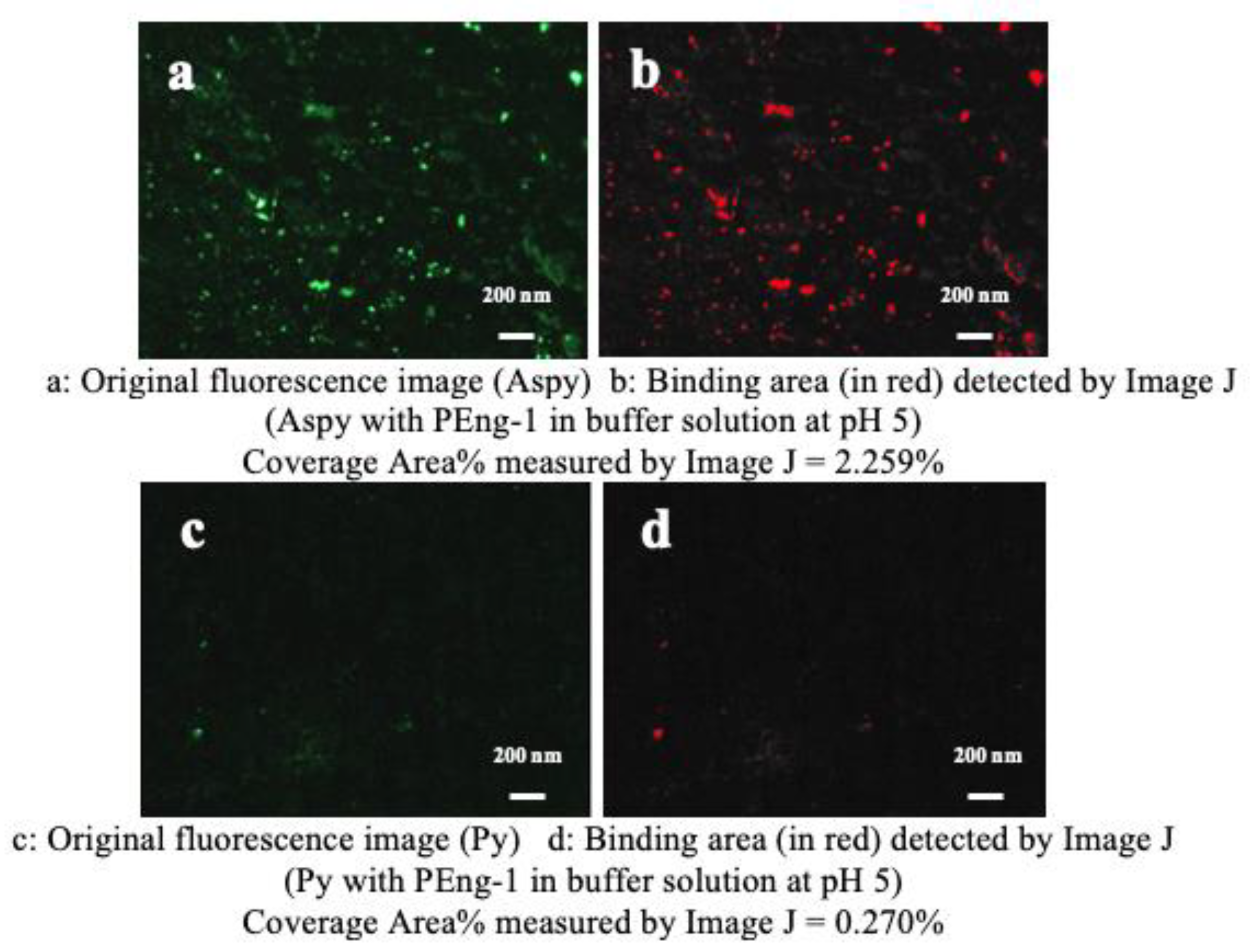
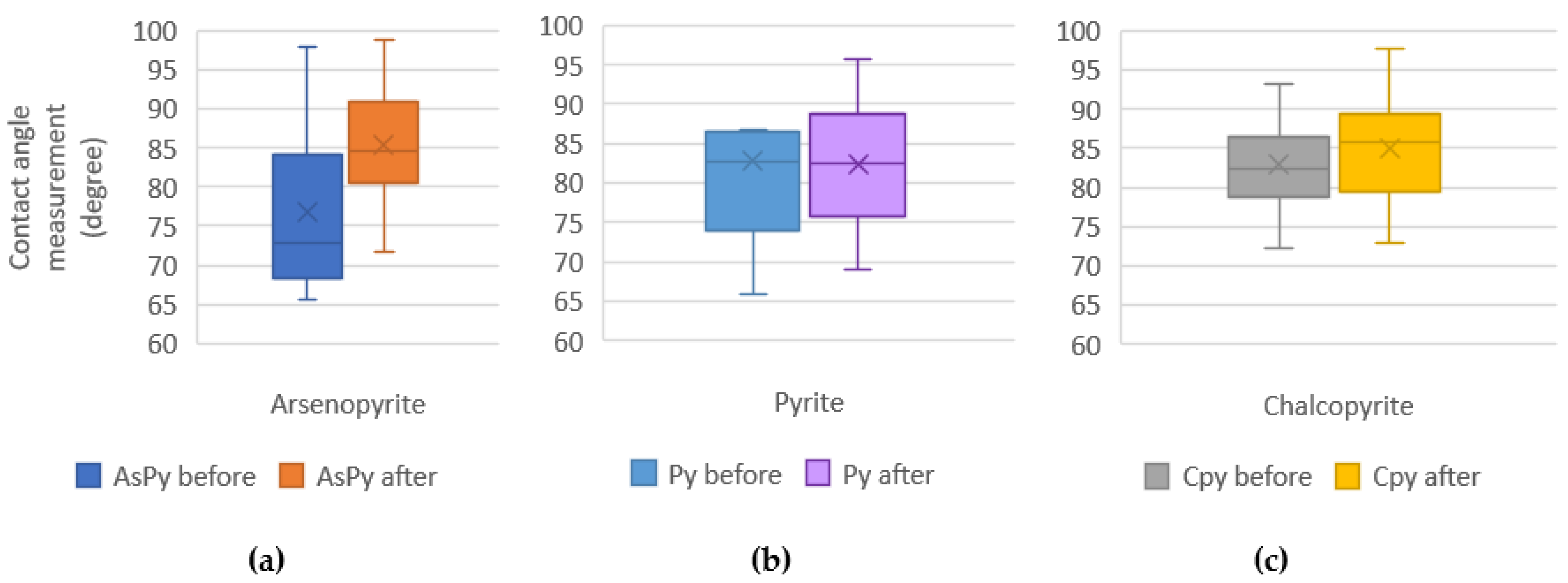
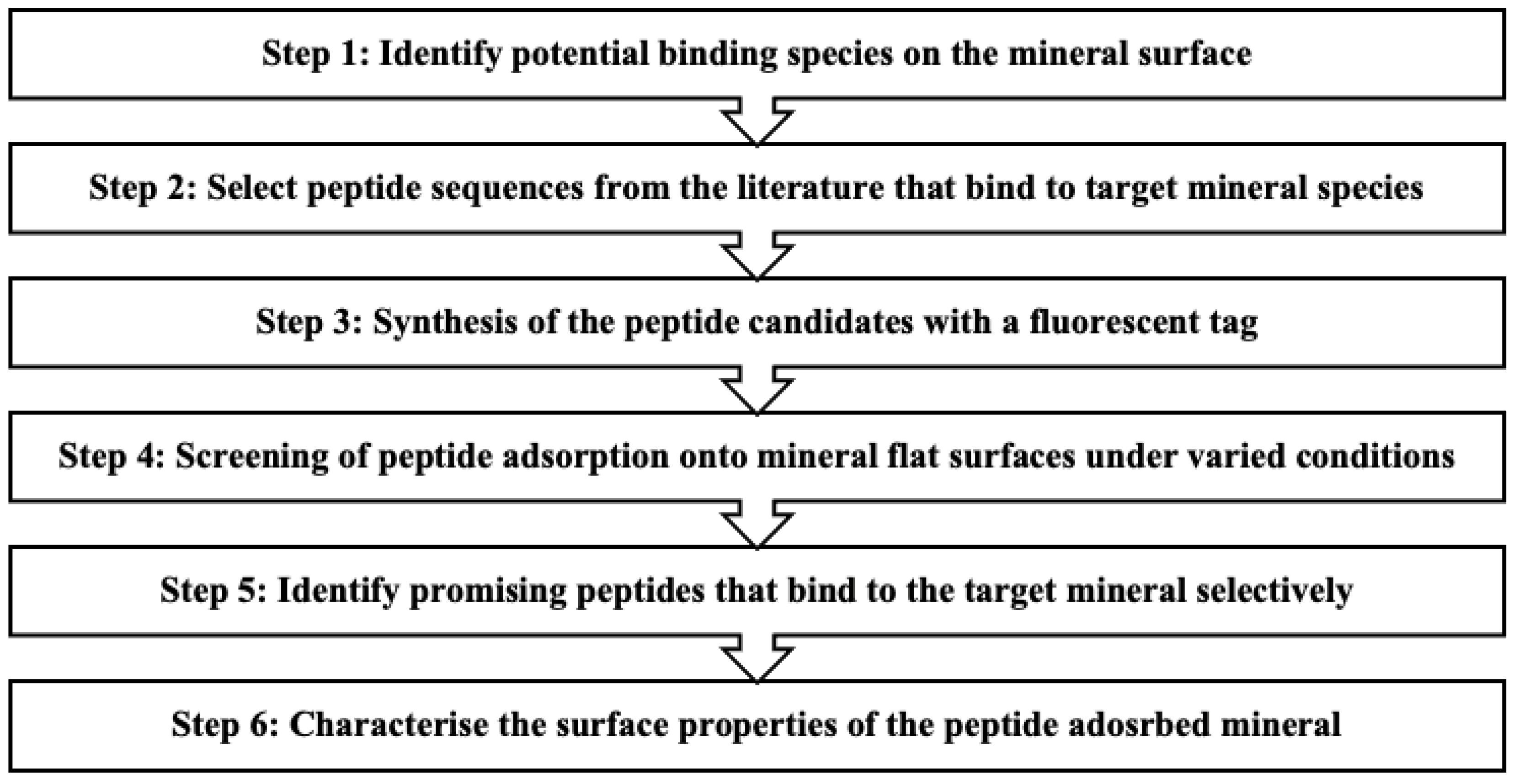
| Category | Target Substance (i.e., Selective to) | Amino Acid Sequence | The Identified Peptide Can Distinguish the Target Substance from | Reference | Peptide Candidate Code * |
|---|---|---|---|---|---|
| Enargite binding peptides | Enargite (Cu3AsS4) | MHKPTVHIKGPT | Silica and Chalcopyrite | [13] | PEng-1 |
| NPEHAAFSPVTV | Pyrite and Chalcopyrite | Patent WO/2018/052134 | PEng-2 | ||
| SKDGAGAAKRTS | Pyrite and Chalcopyrite | Patent WO/2020/085219A1 | PEng-3 | ||
| Arsenic-ion binding peptides | As(III) | TQSYKHG | As(V), Zn2, Cd2+, Fe3+ and Cu2+ | [36] | PAs3 |
| As(III) and As(V) | TPSGDMQ | Zn2, Cd2+, Fe3+ and Cu2 | PAs35 | ||
| Arsenic-oxyanions binding peptides | Arsenic oxyanions | FHMPLTDPGQVQ | No information could be found. | [37] | PAsO-1 |
| SIHSVTKGRYPV | PAsO-2 |
| ARSENOPYRITE | PYRITE | |||||
|---|---|---|---|---|---|---|
| PEPTIDE | pH 5 | pH 7 | pH 9 | pH 5 | pH 7 | pH 9 |
| PENG-1 | ×/√/√√ | ×/√√√/√√√ | ×/√/√ | √√/√/√√ | √/√√/× | √√/×/× |
| PENG-2 | ×/× | ×/× | ×/× | ×/× | ×/× | ×/× |
| PENG-3 | ×/× | ×/× | ×/× | ×/× | ×/× | ×/× |
| PASO-1 | ×/×/×/√ | √/×/×/× | ×/√/×/× | ×/×/×/× | ×/×/×/× | ×/×/×/× |
| PASO-2 | √√√/√√/√√ | √√/√/√ | √√/×/× | √√/√√/√√ | √√/√/√ | √√/×/× |
| PAS3 | ×/× | ×/× | ×/× | ×/× | ×/× | ×/× |
| PAS35 | ×/× | ×/× | ×/× | ×/× | ×/× | ×/× |
| PAsO-1 with BRB | |||
|---|---|---|---|
| Minerals | pH 5 | pH 7 | pH 9 |
| AsPy | √√√/√√√/√√ | √/×/√ | √/×/√ |
| Py | √/√/√ | √/√/√ | ×/×/× |
| Eng | √/√√/√ | ×/×/× | ×/×/× |
| Cpy | √√/√√/√√ | ×/×/× | ×/×/× |
| PEng-1 with BRB | |||
| pH 5 | pH 7 | pH 9 | |
| AsPy | √√√/√√√/√√√ | √√/√√/√ | √√/√/√√ |
| Py | √/√/√ | √/√/√ | √√/√/√√ |
| Eng | ×/× | ×/× | ×/× |
| Cpy | √√/√√/√√ | √/√/√√ | √√/√√/√√ |
| PAsO-2 with BRB | |||
| pH 5 | pH 7 | pH 9 | |
| AsPy | √√√/√√/√√ | √/×/√ | √/√/× |
| Py | √/√/√ | √/√/√ | ×/√/√ |
| Eng | √/√√/√ | ×/√/√ | ×/√/× |
| Cpy | √/√/√ | √/√/√ | √/√/× |
| PEng-1 with BRB and MIBC | |||
|---|---|---|---|
| Minerals | pH 5 | pH 7 | pH 9 |
| AsPy | √√/√√/√√√ | √√/√√√/√√ | √/√/√ |
| Py | √/√/√√ | √/√/√ | ×/√/√ |
| Eng | ×/× | ×/× | ×/× |
| Cpy | √√/√√/√√ | √√/√√/√√ | √√/√/√ |
| PAsO-1 with BRB and MIBC | |||
| pH 5 | pH 7 | pH 9 | |
| AsPy | √√√/√√√/√√ | √/×/√ | ×/×/× |
| Py | √√/√/√√ | ×/√/√ | ×/×/× |
| Eng | √/√/√ | ×/×/× | ×/×/× |
| Cpy | √√/√√/√√ | ×/×/× | ×/×/× |
| PAsO-2 with BRB and MIBC | |||
| pH 5 | pH 7 | pH 9 | |
| AsPy | √/√√/√√ | √/×/√ | √/√/× |
| Py | √√/√/√√ | √/√√/√ | ×/√/√ |
| Eng | √/×/√ | √/×/× | ×/×/× |
| Cpy | √/√/√ | √/√/√ | √/√/√ |
Disclaimer/Publisher’s Note: The statements, opinions and data contained in all publications are solely those of the individual author(s) and contributor(s) and not of MDPI and/or the editor(s). MDPI and/or the editor(s) disclaim responsibility for any injury to people or property resulting from any ideas, methods, instructions or products referred to in the content. |
© 2024 by the authors. Licensee MDPI, Basel, Switzerland. This article is an open access article distributed under the terms and conditions of the Creative Commons Attribution (CC BY) license (https://creativecommons.org/licenses/by/4.0/).
Share and Cite
Ku, L.I.; Forbes, L.; Brito e Abreu, S. An Efficient Peptide Screening Method for Mineral-Binding Peptides. Minerals 2024, 14, 207. https://doi.org/10.3390/min14020207
Ku LI, Forbes L, Brito e Abreu S. An Efficient Peptide Screening Method for Mineral-Binding Peptides. Minerals. 2024; 14(2):207. https://doi.org/10.3390/min14020207
Chicago/Turabian StyleKu, Lam Ian, Liza Forbes, and Susana Brito e Abreu. 2024. "An Efficient Peptide Screening Method for Mineral-Binding Peptides" Minerals 14, no. 2: 207. https://doi.org/10.3390/min14020207
APA StyleKu, L. I., Forbes, L., & Brito e Abreu, S. (2024). An Efficient Peptide Screening Method for Mineral-Binding Peptides. Minerals, 14(2), 207. https://doi.org/10.3390/min14020207







